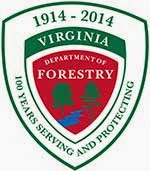
On July 7, 2008, an infestation of the
emerald ash borer was discovered in dying ash trees by Andrew Brown, VDOF forester for Halifax County, while visiting family in a residential development in Herndon, Va., near the Dulles Access Road. Two days later, another infestation was discovered on the other side of Fairfax County in Springfield, just west of I-95. Both infestations appear to have begun some years ago, indicating that the wood boring insects, which have a one-year life cycle, have likely spread to many other areas. Eradication measures for this insect pest will, therefore, be very difficult to implement.
Officials from the
Fairfax County Forest Pest Program, Virginia Department of Agriculture and Consumer Services (VDACS),
Virginia Dept. of Forestry, and many others, are actively searching for more evidence of infestation in Fairfax and adjacent counties. VDACS will likely soon issue a quarantine that prevents all ash material from leaving Fairfax County. Additional counties will likely be quarantined as well if and when the borer is discovered there.
The emerald ash borer is a highly destructive invasive species that has already killed millions of ash trees in Michigan and Ohio and may, ultimately, cost billions of dollars in tree removal and replacement costs. Since its discovery in 2002 in the Detroit area, it has spread to seven additional states (Ohio, Illinois, Indiana, Pennsylvania, Maryland, West Virginia and Virginia). It is also found in Ontario, Canada.
While it spreads at the rate of about two miles per year on its own, this wood-infesting beetle can be moved great distances by human transport of infested wood products, particularly firewood. Firewood for sale in Virginia is brought in from many different states, and many out-of-state travelers bring firewood with them to go camping throughout Virginia’s state and federal lands. Most new infestations have been located either near campgrounds or adjacent to major interstate corridors.
All species of ash trees of all ages, sizes and relative health are vulnerable to the emerald ash borer. The insect is usually very difficult to detect because ash trees typically don’t show any obvious signs of infestation until one year or more after the insect has attacked the tree. By then, the insects will have moved on to attack other trees. Traps for monitoring the insect are available and have been widely distributed by VDACS. However, these traps are not attractive to the beetles from long distances and, therefore, aren’t highly effective for early detection and for precisely locating infested areas. Research for improving these monitoring tools is ongoing.
The only control measure available is to cut and chip infested trees. An effective systemic insecticide for individual tree protection has recently been approved and may be widely available within a year, but this will be very expensive and not practical for halting the progress of the insect. Over the long run, homeowners and municipalities should consider replacing ash trees with other species that are not susceptible to emerald ash borer. It is highly likely this pest will eventually become established across Virginia, although government officials, pest specialists and arborists will work together to limit and/or slow its eventual spread.
For more information on what you can do to abate the threat of exotic pests such as the Emerald Ash borer visit the
Don't Move Firewood website




